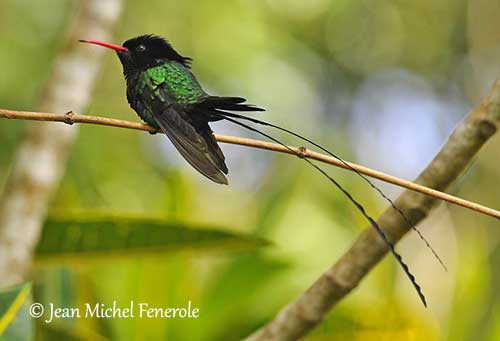
Fr: Colibri à tête noire
Ang: Red-billed Streamertail
All: Rotschnabel-Jamaikasylphe
Esp: Colibrí Portacintas Piquirrojo
Ita: Vessillario beccorosso
Nd: Wimpelstaartkolibrie
Sd: rödnäbbad vimpelkolibri
Photographers:
Jean Michel Fenerole
Photos d’Oiseaux du monde
Ken Havard
My Bird Gallery & Flickr gallery 1 & Flickr gallery 2
Dubi Shapiro
Dubi Shapiro Photo Galleries
Text by Nicole Bouglouan
Sources:
HANDBOOK OF THE BIRDS OF THE WORLD Vol 5 by Josep del Hoyo-Andrew Elliott-Jordi Sargatal - Lynx Edicions - ISBN: 8487334253
BIRDS OF THE WEST INDIES – by Herbert Raffaele, Kristin Williams et Tracy Pedersen – Helm – ISBN: 9780713649055
Meet the Streamertail, the 'Most Beautiful Bird in Jamaica'
Bird of the Month - August 2006 - Red-billed Streamertail (Trochilus polytmus)
Neotropical Birds – Cornell Lab of Ornithology
Animal Diversity Web (University of Michigan Museum of Zoology)
Wikipedia, the free encyclopaedia
Red-billed Streamertail
Trochilus polytmus
Apodiformes Order – Trochilidae Family
INTRODUCTION:
The Red-billed Streamertail is the most abundant and widespread hummingbird in Jamaica. It is the National Symbol of Jamaica.
It feeds on nectar from both native and introduced flowers, but it also consumes some insects and spiders. This species occurs from sea-level to montane forests, and also frequents man-made habitats.
The Red-billed Streamertail is locally known as “doctor bird”. This name comes from the erect black crest and the long tail feathers that resemble the top hat and coat-tails used by doctors in the old days.
This bird was also named “God bird” by the Arawak Indians who believed this hummingbird had magical powers and was the reincarnation of dead souls.
The Red-billed Streamertail has restricted range in which it is widespread and resident. This species is not currently threatened.

DESCRIPTION OF THE BIRD:
Biometrics:
Male:
Length: 22-30 cm (including bill and tail)
Tail length: 13-17 cm
Weight: 5,2 g
Female:
Length: 10-11 cm
Weight: 4,4 g
The Red-billed Streamertail is sometimes confused with the Black-billed Streamertail (T. scitulus) which has black bill at all ages.
The Red-billed Streamertail male has iridescent emerald green body plumage, slightly darker on back. On the wings, the flight-feathers are dark brown to blackish. The forked tail is black with greatly elongated second outermost rectrices (streamers). These long feathers are scalloped and fluted on the inside. When the bird is perched, the streamers are crossed.
The head is black with elongated laterals crown feathers and ear-coverts extending beyond the nape.
The straight bill (2-3 cm) is red with black tip. The eyes are dark brown. Legs and feet are blackish.
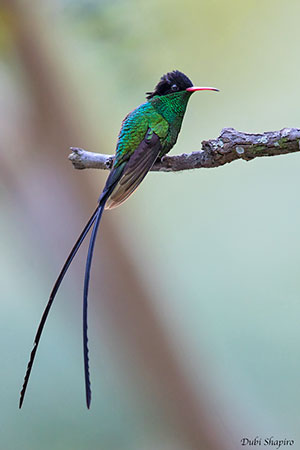
The female has green upperparts whereas underparts are white, with some green spots on breast sides and belly. The tail has green central rectrices, while the others are dark blue with broad white tips. She lacks the streamers.
She has red bill but duller than male, with blackish distal part.
The juvenile has black upper mandible with red only at bill base. The immature male is similar to adult but it lacks the streamers.
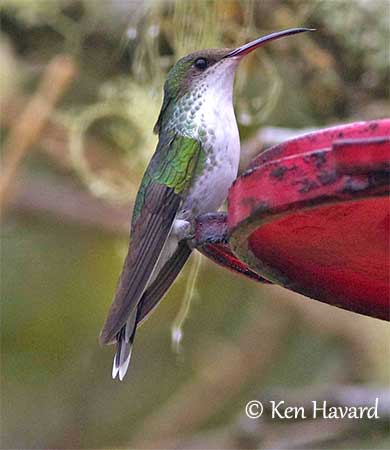
RANGE:
The Red-billed Streamertail is found in Jamaica, except in extreme E.
HABITAT:
The Red-billed Streamertail frequents a variety of habitats and can be seen within or along the edges of montane forests. It also frequents man-made habitats such as plantations, parks and gardens.
This species is most common at 1,000 metres of elevation, but it occurs from coastal areas to higher elevations where it can be seen mainly after breeding.
CALLS AND SONGS: SOUNDS BY XENO-CANTO
The Red-billed Streamertail gives loud, metallic “ting” or “teet”, and a descending, prolonged “twink-twink-twink”. These calls are used to communicate during mating and territory defence.
The male produces a non-vocal sound during the flight by using the streamers. The scalloped and fluted long feathers produce a whirring sound during the flight. However, from recent research, this noise could be produced by the wing feathers, and especially two of the outermost three primaries.
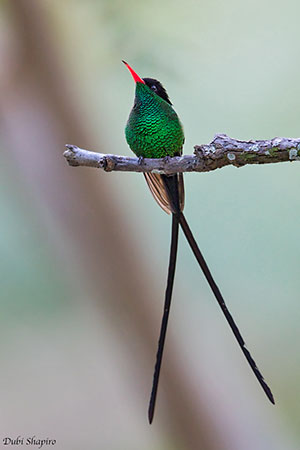
BEHAVIOUR IN THE WILD:
The Red-billed Streamertail typically feeds on nectar from flowers, especially brightly coloured, fragrant flowers of a variety of trees, herbs, shrubs and epiphytes.
It usually feeds on tubular-shaped flowers, inserting the long bill into the flower’s tube and then, using the long, straw-like tongue to collect the nectar. It feeds while hovering, although some individuals also feed while hanging on to the flower.
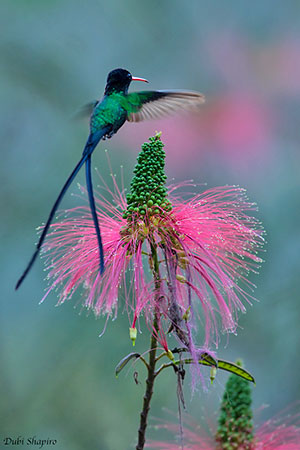
However, they also feed on small insects, between 3 and 20 metres above the ground. Insects are taken from the air or from the vegetation. It may catch spiders from their webs too.
The female usually feeds more on insects than the male, especially during the chick-feeding period.
The feeding territories are aggressively defended against competitors with aerial and intimidation displays.
The Red-billed Streamertail breeds year-round. The birds perform courtship displays in three phases.
During the first display, the female flies into the male’s territory and lands close to it and then, they threaten each other. The second phase shows the female shaking her head up and down. Then, the male performs a U-shaped flying pattern accompanied by song. During this display, it hovers while waving the tail to enhance the streamers. And finally, the copulation occurs after 4-6 rounds of displays.
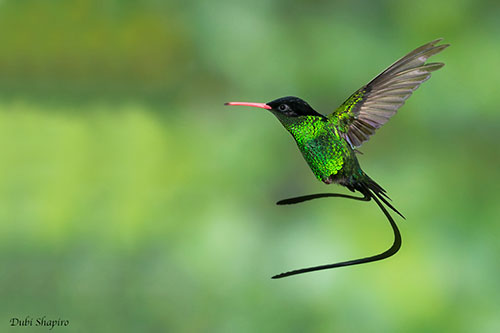
The Red-billed Streamertail is resident in Jamaica, but some individuals move to higher elevations after the main breeding season.
Like all Trochilidae, it is very agile in flight and hovers while feeding or displaying.
REPRODUCTION OF THIS SPECIES:
The Red-billed Streamertail breeds year-round, with the main period in April-June.
It builds a cup-shaped nest with plant fibres, spider webs and lichen, the latter usually used on the outer wall. This structure is placed on thin twig, between 1 and 3 metres above the ground.
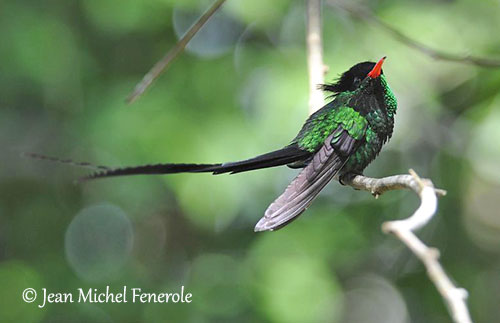
The female lays two whitish eggs and incubates alone during 17-19 days. At hatching, the chicks are black with two dorsal rows of pale grey down. They usually fledge 19-24 days after hatching, but they remain with the female for 3-4 weeks after fledging.
This species produces up to three broods per year.
PROTECTION / THREATS / STATUS:
The Red-billed Streamertail has restricted range, but it is widespread through most of Jamaica in a wide variety of habitats.
The global population size is unknown but the species is described as “common”.
The Red-billed Streamertail is not globally threatened and currently evaluated as Least Concern.
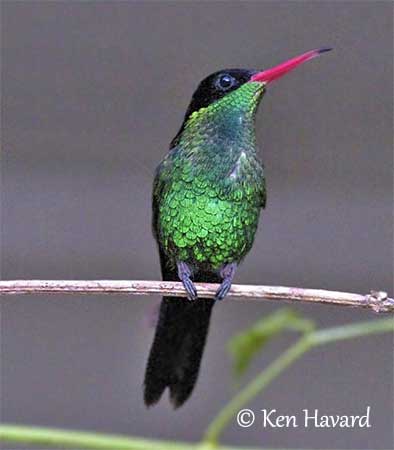
Male after moulting.
The streamers are lacking.